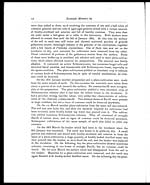Medicine - Institutions > Army health reports and medical documents > Scientific memoirs by medical officers of the Army of India > Part III, 1887 > 1 - Notes from the biological laboratory attached to the Office of the Sanitary Commissioner with the Government of India
(17) Page 11
Download files
Individual page:
Thumbnail gallery: Grid view | List view

11
Medical Officers of the Army of India.
and, together with the other parts of the plants, at once burned. An area in
which the blight has appeared should be left unoccupied for some time, and, if
possible, should be isolated by means of encircling it with a trench excavated to
a level below that to which the roots of the plants descend. By means of such
measures a limitation to the spread of the disease may be looked for, but with-
out isolation, and specially without careful removal and destruction of all
portions of morbid tissue, the disease, once established, may be expected to go
on continuously radiating over areas of wider and wider radius.
On the Results of Cultivations of Choleraic Comma-Bacilli in Earth,
in Cowdung, and in Human Excreta.
One of the great objections to accepting the view that the choleraic comma-
bacilli are really the essential cause of the disease is their apparent incapacity
for assuming a resting condition and their apparent general feebleness in the
struggle for existence. There were many phenomena on record regarding the
occurrence of outbreaks of cholera within areas where the disease is only an
occasional epidemic visitor which certainly appear to indicate that, if the
morbific agent be of an organised nature, the causative organism must be
capable of enormous multiplication under exposure to the prevailing local con-
ditions at certain times, and that at others it must be able to pass for prolonged
periods into a condition of dormancy. Within the endemic area, too, certain
phenomena in the seasonal cycle of prevalence are very hard to explain, save as
dependent on the alternation of periods of activity and of rest, or, at all events,
of periods during which the local conditions favour or repress the multiplication
of the exciting cause. During the course of the past season, a renewed attempt
has been made to determine how far the choleraic comma-bacilli are capable
of holding their own under external conditions such as those prevailing in
Calcutta, and in media to which they are specially likely to gain access in
large numbers under ordinary circumstances. The media to which choleraic
materials are specially likely to attain access in bulk are, of course, water and
soil of varying degrees of purity or organic contamination, and as it appears to
have been clearly shown that the commas rapidly disappear from water without
any attempt at the development of resting forms, attention was specially direct-
ed to the subject of their behaviour in soil. A series of experiments was, there-
fore, initiated in the middle of December, that is, just at the time at which the
minor of the two annual periods of minimum prevalence of cholera in Calcutta
normally begins to manifest itself, on the effects following the introduction of
large masses of choleraic commas into portions of common garden soil.
On the 16th of December two small glass beakers were filled with garden-
earth which had been thoroughly triturated with a certain amount of fresh, nor-
mal human excreta. The contents of five tube cultivations of cholera commas
C 2
Set display mode to: Large image | Zoom image | Transcription
Images and transcriptions on this page, including medium image downloads, may be used under the Creative Commons Attribution 4.0 International Licence unless otherwise stated. ![]()
| Permanent URL | https://digital.nls.uk/75004051 |
|---|
| Shelfmark | IP/QB.10 |
|---|---|
| Additional NLS resources: | |




